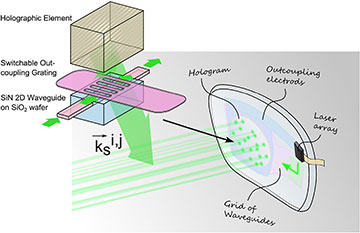
Detailed illustration of one emissive point on the see-through holographic retinal-projection device. [Image: Optica, doi: 10.1364/OPTICA.5.001200][Enlarge image]
A new concept for a transparent, near-eye, lens-free optical display uses both integrated-photonics light distribution and digital holography technology to form an image in the eye itself (Optica, doi: 10.1364/OPTICA.5.001200). In theory, the optical display matches the coherence of photons from a light image using 2-D waveguides and synchronizes them using holographic elements. The resulting wavefronts are projected directly onto the retina, which the brain reads as a picture. Results from the French research team’s initial optical simulations suggest that such a retinal-projection display could be used in lightweight, compact, near-eye devices, including smart glasses.
Forming images directly on the retina
In traditional near-eye optical displays, image pixels generate a spherical wavefront that cannot be corrected by the eye. These displays require equipment that reduces the curvature of the wavefront, to produce a more planar wavefront with angular coordinates focused on the retina that can be transformed by the brain into a clear, sharp image.
The new optical-system design proposed by team lead Christophe Martinez and his colleagues, at the Université Grenoble Alpes, France, reduces the traditional design’s bulk by forming the image directly in the eye, eliminating the need for additional equipment to flatten photon wavefronts and to fix the angle at which they enter the eye. To do so, the team employed a lens-free design that can generate planar wavefronts using a 2-D grid of optical waveguides and switchable holographic elements—all of which fit on the surface of a normal-looking pair of glasses.
Image formation using the new optical system begins with an image projected from a laser array. Photons from the image enter a waveguide distribution array that matches the photons’ coherence. Next, the holographic elements define the direction of the coherent photons and synchronize them via a reference light beam. When the photons exit the holographic elements, they form wavefronts in front of the eye that correspond to the laser-array image. The eye focuses the wavefronts onto the retina, and they are translated by the brain as the laser-array image. Outcoupling electrodes in the system are switchable, which allows the user to activate or deactivate wavefront emission, thereby refreshing or changing the projected image.
Possible applications
The team completed a theoretical overview and a series of concept simulations of their see-through holographic retinal-projection display. Through this work, the researchers identified waveguide integration and self-focusing efficiency as limiting the system’s image resolution. They also noted in the study that the “use of holographic elements limits the projection to a monochromatic image, and a fast holographic recording process has yet to be demonstrated.”
Despite these limitations, the team believes that results from the optical simulations could be seen as “a fundamental reflection on new opportunities for retinal projection that are opened by recent technological achievements in integrated photonics and holography.”
The research team believes that this work may someday inspire retinal-projection displays for augmented reality, virtual reality and mixed reality applications—including smart glasses for hands-free computing or as a tool to help people with vision problems navigate everyday tasks. According to a press release accompanying the work, the team now aims to develop and test the individual components of a working device, with an eye toward creating a prototype.
[Correction, 16 October 2018, 10:30 a.m. EDT:] The last three paragraphs have been slightly revised to remove the implication that the technique is limited to static images. According to the authors, this limitation applies only to the initial prototype.]
